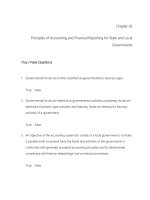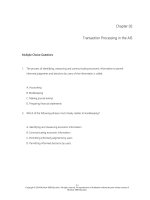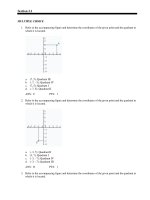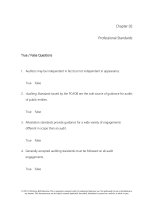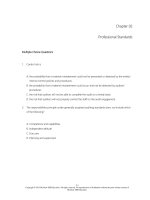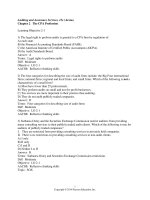World politics trend and transformation 2010 2011 edition 13th edition kegley test bank
Bạn đang xem bản rút gọn của tài liệu. Xem và tải ngay bản đầy đủ của tài liệu tại đây (156.23 KB, 13 trang )
Chapter 2: Theories of World Politics
TRUE/FALSE
1. A theory is an example, model, or essential pattern that structures thought about an area of inquiry.
ANS: F
DIF: High
REF: 30
2. Realism is important to study because it continues to guide much thought regarding international
relations.
ANS: T
DIF: Low
REF: 31
3. Realists view the state as the most important actor in international politics.
ANS: T
DIF: Low
REF: 32
4. When states agree that an act of aggression by any state will be met by a collective reaction from all
other states is known as the security dilemma.
ANS: F
DIF: Medium
REF: 33
5. The theory that peace and stability are most likely to be maintained when military is distributed so as
to prevent any state from acquiring a disproportionate amount of power is known as balance of power.
ANS: T
DIF: Low
REF: 33
6. According to realist theory, a state’s leaders are morally obligated to conduct foreign policy in an
ethical manner.
ANS: F
DIF: Medium
REF: 33
7. Unlike neo-realists, neo-liberals believe that international anarchy can be overcome through the
creation of strong global institutions.
ANS: T
DIF: Low
REF: 39
8. Complex interdependence is a core concept of neo-realism and describes how the growing ties among
transnational actors makes them more vulnerable and sensitive to one another.
ANS: F
DIF: High
REF: 41
9. Feminist theory has more in common with neo-liberalism than with realism.
ANS: T
DIF: Medium
REF: 54
10. The Kellogg-Briand Pact, which outlawed war as an instrument of national policy, is widely credited
with keeping the peace after World War II.
ANS: F
DIF: Low
REF: 34
11. Liberalism believes that global politics is primarily a zero-sum game.
ANS: F
DIF: Low
REF: 38
12. Liberals believe that war is a global problem that requires collective action to control it.
ANS: T
DIF: Low
REF: 40
13. Liberals believe that establishing stable democracies will lead to peace.
ANS: T
DIF: Low
REF: 38
14. Liberal reforms after World War I stressed the ideal of self-determination, which meant that the states
that lost the war were allowed to determine whether or not to continue to have standing armies.
ANS: F
DIF: Medium
REF: 38
15. The organization associated with liberal thought is the United Nations.
ANS: F
DIF: Medium
REF: 43
16. Complex interdependence focuses on multiple sources of communication rather than just government
to government relations.
ANS: T
DIF: Low
REF: 41
17. Constructivism is the study of how the global system is constructed or managed.
ANS: F
DIF: Medium
REF: 46
18. Dependency theory states that peace can best be achieved by economic interdependence.
ANS: F
DIF: High
REF: 52
19. The theory that denies the possibility of an unbiased objective study of international relations is
deconstructivism.
ANS: T
DIF: Medium
REF: 56
MULTIPLE CHOICE
1. A set of conclusions derived from assumptions and/or evidence about some phenomenon is called a
a. construction.
b. global system.
c. paradigm.
d. deconstruction.
e. theory.
ANS: E
DIF: LOW
REF: 30
2. Realists believe states are the most important actors in global politics because
a. state leaders are stronger than the leaders of non-governmental organizations.
b. international law recognizes states as the most important actors.
c. states answer to no authority higher than themselves.
d. international organizations have no impact on global politics.
e. there are more states than NGOs.
ANS: C
DIF: High
REF: 32
3. According to realists, the anarchic structure of the international system leads to
a. a reliance on collective security arrangements.
b. greater cooperation among states.
c. chaos in interstate relations.
d. increased interdependence among states.
e. a self-help system where states are responsible for their own security.
ANS: E
DIF: Medium
REF: 32
4. Which of the following individuals best represents a pioneer of the realist perspective on international
relations?
a. Adam Smith
b. Immanuel Kant
c. Woodrow Wilson
d. Richard Cobden
e. Niccoli Machiavelli
ANS: E
DIF: Medium
REF: 31-32
5. According to realist theory, the primary goal of every state is
a. to promote its national interest.
b. to negotiate alliances with allies.
c. to strengthen international collective security arrangements.
d. to limit nuclear proliferation.
e. to increase its economic wealth.
ANS: A
DIF: Medium
REF: 32
6. Modern realism emerged as a reaction to
a. the failure of cooperation among nations to keep the peace after World War I.
b. the failure of diplomacy during the Peloponnesian War.
c. the horrific devastation of World War I.
d. the collapse of the Soviet Union and the end of the Cold War.
e. the emergence of the United States as a superpower at the end of World War II.
ANS: A
DIF: Medium
REF: 34
7. During the Cold War, the ideology that was most prominent was
a. realism.
b. liberalism.
c. idealism.
d. constructivism.
e. behavioral science.
ANS: A
DIF: Low
REF: 34
8. The principle that the governments of states are subject to no higher authority is
a. national interest.
b. collective-security.
c. state-sovereignty.
d. balance of power.
e. security dilemma
ANS: C
DIF: Medium
REF: 45
9. Which of the following is a tenet of realism?
a. People are selfish and ethically flawed with a lust for power.
b. The goal of every state is to promote its national interest.
c. Military might is more important to a state's national security than economics.
d. Might makes right.
e. All of the above are true.
ANS: E
DIF: Low
REF: 32-33
10. The tendency of states to view the military build-up of other states as threatening is known as
a. self-help.
b. balance of power.
c. security dilemma.
d. relative gains.
e. collective security.
ANS: C
DIF: Medium
REF: 33
11. The typical result of the security dilemma is a(n)
a. balance of power.
b. collective security arrangement.
c. nuclear weapons proliferation.
d. arms race.
e. self-help system.
ANS: D
DIF: High
REF: 33
12. The balance of power theory is best described by which of the following statements?
a. States are independent and must rely on themselves for security and well-being.
b. A condition in which some states benefit more than others.
c. Peace and stability is best achieved when there is no single superpower capable of
controlling the world.
d. The tendency of states to view the military build-up of adversaries as threatening.
e. All of the above are true.
ANS: C
DIF: High
REF: 33
13. Which of the following is the primary difference between realism and neo-realism?
a. Realists focus on the selfish nature of individuals whereas neo-realists believe human
beings are naturally cooperative.
b. Neo-realists believe that international anarchy, not the selfish nature of individuals, is
responsible for the competitive nature between states.
c. Realists focus on national security issues whereas neo-realists focus on economic matters.
d. Neo-realists believe that states are naturally cooperative while realists believe that states
are naturally competitive.
e. Realists believe that national security issues are paramount while neo-realists believe that
social issues such as the environment and poverty should be at the forefront.
ANS: B
DIF: High
REF: 35
14. Which of the following was a criticism of the realist school of thought?
a. It was too idealistic.
b. It could not account for new trends in international relations, like economic cooperation.
c. It was too precise in how it defined key terms, like power and interest.
d. Both b and c above.
e. All of the above are true.
ANS: B
DIF: Medium
REF: 36
15. Liberal theory promotes which of the following as a solution to global conflict?
a. an expansion of democratic governments
b. an emphasis on free trade
c. reliance on global institutions
d. dependence on collective security arrangements
e. All of the above are true.
ANS: E
DIF: Medium
REF: 37-39
16. A conflictual relationship in which what is gained by one side is lost by the other is known as
a. collective-security.
b. balance of power.
c. zero-sum game.
d. constructivism.
e. complex interdependence.
ANS: C
DIF: Medium
REF: 38
17. Who of the following was not an important liberal philosopher?
a. John Locke
b. Immanuel Kant
c. Adam Smith
d. Hans Morgenthau
e. Woodrow Wilson
ANS: D
DIF: Medium
REF: 37-38
18. Which of the following is not a basic tenet of liberal thought?
a. Human nature is essentially altruistic and cooperative.
b. Morality should be a part of politics.
c. Violence is a product of bad institutions, not bad people.
d. Unilateralism is the best means to prevent war.
e. War is not inevitable.
ANS: D
DIF: High
REF: 37-39
19. Which of the following is not an element common to the various schools of liberalism?
a. International institutions are important actors that can mediate disputes among states.
b. Establishing stable democratic governments will enhance the prospects of peace.
c. States’ concerns about relative gains impede cooperation.
d. Free trade gives states a material incentive to maintain peaceful relations.
e. All of the statements above are common elements in the various schools of liberalism.
ANS: C
DIF: High
REF: 37-39
20. Which of the following are components of liberal theory?
a.
b.
c.
d.
Individuals need to substitute loyalty to humankind for loyalty to states.
Individuals are basically moral and ethical.
The well being of individuals is more important than national interests.
Education can change world public opinion against war.
e. All of the above are true.
ANS: E
DIF: Low
REF: 37-38
21. A security arrangement guided by the principle that an act of aggression by any state will be met by a
collective response from the rest is known as
a. the Kellogg-Briand Pact.
b. a self-help system.
c. geopolitics.
d. collective security.
e. alliance building.
ANS: D
DIF: Low
REF: 40
22. Which of the following is the best example of complex interdependence?
a. global trade
b. al-Qaeda
c. the United Nations
d. ethnic groups
e. All of the above are true.
ANS: A
DIF: High
REF: 41
23. According to the text, a common critique of liberalism is that
a. international institutions are ineffective.
b. states are the primary level of analysis.
c. it places too much emphasis on moral rationales.
d. Both a and c
above.
e. All of the above are true.
ANS: D
DIF: Medium
REF: 44-45
24. _________________ refers to the areas of economics, finance, and environmental affairs.
_______________ refers to the area of national defense.
a. Liberalism; realism
b. Low politics; high politics
c. Zero-sum; regimes
d. Diplomacy; collective security
e. Complex interdependence; transnational relations
ANS: B
DIF: Medium
REF: 44
25. Complex interdependence
a. is used by realists to argue in favor of relative gains as opposed to zero-sum gains.
b. stress ties between transnational actors, not just states, and focuses on issues besides
national security.
c. emphasizes security issues and the prominence of states in the international system.
d. is the result of states refusing to work together on global trade issues.
e. is most closely associated with realism.
ANS: B
DIF: Medium
REF: 41
26. An international regime
a. brings some order to international anarchy.
b. is a body of norms that facilitates cooperation on a specific issue.
c. can apply to a variety of issues, such as trade, monetary affairs, and the environment.
d. is the result of increasing interdependence in the international system.
e. All of the above are true.
ANS: E
DIF: High
REF: 41
27. The school of thought that emphasizes the importance of shared ideas and understandings that are
developed between actors that define their interests, identities and images of the world is called
a. feminism.
b. realism.
c. international regimes.
d. constructivism.
e. complex interdependence.
ANS: D
DIF: Medium
REF: 46
28. Which of the following statements is not true about constructivism?
a. Constructivism rejects the notion of international anarchy.
b. Constructivism attempts to explain how all paradigms depend on an inter-subjective
consensus about core concepts.
c. Constructivism provides a lens for examining intellectual fads.
d. Constructivism is sometimes described as more of a philosophy than a theory.
e. All of the above are true about constructivism.
ANS: A
DIF: High
REF: 46-47
29. Which of the following is not considered a radical critique of the existing system?
a. socialism
b. constructivism
c. feminism
d. dependency
e. All of the above are radical critiques.
ANS: B
DIF: High
REF: 51-53
30. World-system theory divides the world into
a. democratic and non-democratic nations.
b. core, periphery, and semi-periphery areas.
c. bourgeoisie and proletariat.
d. capitalist and command economies.
e. Global North and Global South.
ANS: B
DIF: Medium
REF: 52
31. Feminism challenges traditional international relations theory in all except which of the following
ways?
a. the scientific study of world politics
b. fundamental gender bias
c. the capitalist economic system
d. reformulation of core concepts
e. incorporation of the female perspective
ANS: C
DIF: Medium
32. Deconstructionism postulates that
REF: 53-55
a. low politics are more important than high politics.
b. absolute gains are more important to international actors than relative gains.
c. there is no unbiased, objective view of international relations.
d. gender is a critical element in international relations.
e. All of the above are true.
ANS: C
DIF: Medium
REF: 56
33. The study of world politics using scientific methods based on measurement, data, and evidence is
known as
a. behaviorism.
b. epistemology.
c. hypothesis.
d. constructivism.
e. feminism.
ANS: A
DIF: High
REF: 59
SHORT ANSWER
1. What is a “paradigm”?
ANS:
A paradigm structures thoughts about an area of inquiry.
REF: 30
2. Why did liberals focus on self-determination and democracy after World War I?
ANS:
Democracies historically do not go to war with each other due to
the transparent nature of their governments
leaders in democratic countries are accountable to their electorate
usually interrelated economically and culturally.
REF: 38
3. What are the main criticisms of the realist school of thought?
ANS:
Lack of precision in use of key terms like “power” and “interest.”
Overly vague theorizing
Did not account for significant new developments in world politics, like trade and political institutions
Tendency to disregard ethical principles
REF: 36
4. Which school of thought believes that our understandings of the world are socially constructed and
that prevailing ideas mold our beliefs about what is immutable and what can be reformed?
ANS:
Constructivism
REF: 46
5. A ____________________ consists of a set of hypotheses postulating the relationship between
variables or conditions that are advanced to describe, explain or predict phenomena.
ANS:
theory
REF: 30
6. An international ____________________ is a set of principles, norms and rules governing behavior
within a specified issue area.
ANS:
regime
REF: 41
ESSAY
1. Compare and contrast the assumptions about international phenomena made by liberalism and realism.
What assumptions about the nature of world politics are advanced by each tradition? What accounts
for the rise and fall over time of their relative popularity as paradigms for organizing our orientation
toward the international arena?
ANS:
Student answers will vary.
2. What is the main concern of constructivism? How does it seek to expand on the theories of realism and
liberalism? How useful is constructivism for understanding international phenomena?
ANS:
Student answers will vary.
3. How have feminist scholars been critical of other international relations scholars? Are their critiques
justified?
ANS:
Student answers will vary.
4. Describe socialism including Karl Marx views on capitalism and Lenin’s ideas on imperialism.
ANS:
student answers will vary
